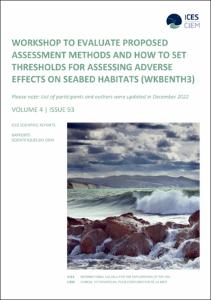| dc.contributor.editor | Kenchington, Ellen | |
| dc.contributor.editor | Raicevich, Saša | |
| dc.date.accessioned | 2023-02-06T20:21:40Z | |
| dc.date.available | 2023-02-06T20:21:40Z | |
| dc.date.issued | 2022 | |
| dc.identifier.citation | ICES (2022) Workshop to evaluate proposed assessment methods and how to set thresholds for assessing adverse effects on seabed habitats (WKBENTH3). Copenhagen, Denmark, ICES, 102pp. ( ICES Scientific Reports, 4:93). DOI: https://doi.org/10.17895/ices.pub.21666260 | en_US |
| dc.identifier.uri | https://repository.oceanbestpractices.org/handle/11329/2135 | |
| dc.description.abstract | The Marine Strategy Framework Directive (MSFD) requires EU Member States to achieve and maintain good environmental status (GES) across their marine waters. WKBENTH3 convened as a hybrid meeting to evaluate benthic assessment methods and indicators for their potential to meet the criteria described under the MSFD Descriptor 6 (seabed integrity). They evaluated a suite of indicator methods, proposed by participants. Those included five indicator methods de-scribing the ‘Condition of the Benthic Habitat’, primarily linked to D6C5, and six indicator meth-ods for ‘Physical Disturbance on Benthic Habitats’, primarily linked to D6C3. Variants of some of the indicators as well as some other commonly used diversity indices were also assessed.
A common dataset with broad regional representation was used to compare and contrast indi-cator performance with 17 benthic invertebrate datasets drawn from a range of pressure gradi-ents (14 over gradients of commercial bottom trawling intensity, 2 over gradients of eutrophica-tion and 1 over a pollution gradient). A meta-analysis of the mean response to trawling across all locations showed that most indicators had, on average, declined at the high trawl impact rel-ative to the baseline and a significant effect of trawling was detected for the indicators Commu-nity Biomass, Species Richness, Fraction of long-lived species, Median longevity, Fraction of sen-tinel species - SoS, Relative Margalef diversity index DM’, Shannon Index and Inverse Simpson. The complementarity of the different indices was computed using Spearman correlation coeffi-cients between each of the indices for all gradients, ordering indicators with Ward’s hierarchical clustering. One of the key findings was the identification of four groups of indices that showed clear patterns of association. Considering the link of indicators to different benthic community properties, WKBENTH3 proposed that the assessment of D6 should be carried out selecting a number of indicators drawn from different cluster groups to ensure that components of diver-sity, species sensitivity and abundance (density and/or biomass – or other proxy linked to benthic habitat functioning) are addressed.
WKBENTH3 further ranked model-based benthic sensitivity and impact outputs across broad habitat types (BHTs) in eight different subdivisions in order to contrast indicator responses. The ranking showed a broad congruence, however, every subdivision had variation in ranking of BHTs among indicator methods. Further work is needed to determine the cause of those discrep-ancies and to look more closely at the values and the response curves generated.
WKBENTH3 developed a worked example of how to estimate thresholds for GES based on the approach of ‘detectable change’. The approach was applied to each of the different pressure gra-dients and to muddy sand habitats. It was not able to estimate thresholds for all gradients da-tasets as the confidence intervals around some relationships were very wide. Experts highlighted that the assessment of seabed integrity needs to ensure that cross-regional, regional, national and local scale assessments can “talk” to each other and that they are complementarity in terms of what aspects of the ecosystem the respective indicators are capturing and what pressure they are tracking (linked to manageable human activity). Cross-regional assessments will inform whether assessments are measuring the same or similar things, allowing for such crosschecking. | en_US |
| dc.language.iso | en | en_US |
| dc.publisher | International Council for the Exploration of the Sea (ICES) | en_US |
| dc.relation.ispartofseries | ICES Scientific Reports;4:93 | |
| dc.rights | Attribution 4.0 International | * |
| dc.rights.uri | http://creativecommons.org/licenses/by/4.0/ | * |
| dc.subject.other | Benthic assessment method | en_US |
| dc.subject.other | Seabed integrity | en_US |
| dc.subject.other | Benthic habitat | en_US |
| dc.subject.other | Marine Strategy Framework Directive (MSFD) | en_US |
| dc.title | Workshop to evaluate proposed assessment methods and how to set thresholds for assessing adverse effects on seabed habitats (WKBENTH3). | en_US |
| dc.type | Report | en_US |
| dc.description.status | Published | en_US |
| dc.format.pages | 102pp. | en_US |
| dc.contributor.corpauthor | International Council for the Exploration of the Sea (ICES) | en_US |
| dc.description.refereed | Refereed | en_US |
| dc.publisher.place | Copenhagen, Denmark | en_US |
| dc.identifier.doi | https://doi.org/10.17895/ices.pub.21666260 | |
| dc.subject.parameterDiscipline | Biota composition | en_US |
| dc.subject.parameterDiscipline | Other biological measurements | en_US |
| dc.description.currentstatus | Current | en_US |
| dc.description.sdg | 14.a | en_US |
| dc.description.maturitylevel | Mature | en_US |
| dc.description.adoption | Validated (tested by third parties) | en_US |
| dc.description.adoption | Multi-organisational | en_US |
| dc.description.adoption | International | en_US |
| dc.description.methodologyType | Method | en_US |
| dc.description.methodologyType | Specification of criteria | en_US |
| obps.contact.contactemail | info@ices.dk | |
| obps.resourceurl.publisher | https://ices-library.figshare.com/articles/report/Workshop_to_evaluate_proposed_assessment_methods_and_how_to_set_thresholds_for_assessing_adverse_effects_on_seabed_habitats_WKBENTH3_/21666260 | |
 Repository of community practices in Ocean Research, Applications and Data/Information Management
Repository of community practices in Ocean Research, Applications and Data/Information Management

